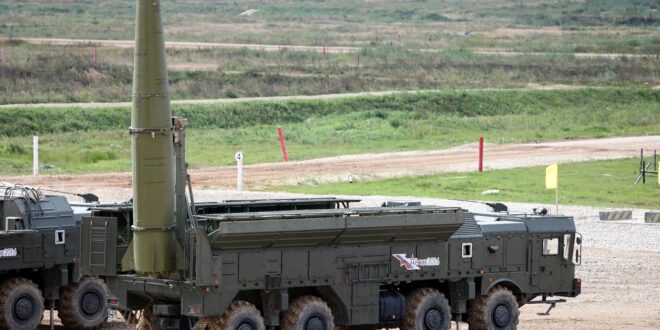The bombing campaign of Russia in Ukraine has certainly left a devastating blow to Ukrainians, with thousands of Ukrainian soldiers killed and hundreds of civilians shelled over the span of almost three weeks worth of fighting.
The total number of those killed by Russian bombs in Ukraine is difficult to confirm. However, it is safe to say that Russian bombardment campaigns have been non-stop since the start of the war. The most recent high-profile bombing was that of a Mariupol maternity hospital, which the Russian Federation tried to justify by saying it was full of Ukrainian soldiers.
One of the munitions Russia had been using throughout the fighting is the 9K720 Iskander mobile short-range ballistic missile system (otherwise known as the SS-26 Stone in the west). More specifically, they had been using the Iskander-M variant of the system that launches 9M723 ballistic missiles that were seen to be fired from mobile launchers.
Russia’s armed forces have benefited from more than a decade of investment and reform. Russia’s ground forces are now better equipped, with artillery central to ground manoeuvre capability. | Read the #MilitaryBalance 2022: https://t.co/4sQPYYdj4n pic.twitter.com/E54Qnqtu9m
— IISS News (@IISS_org) February 24, 2022These missiles are said to be powered by a solid-fuel rocket motor that enables the missile to have a range of over 300 miles, with a speed of around Mach 6-7, and can carry conventional warheads, submunition, earth-penetrator, thermobaric, and more notably, nuclear warheads. Each missile can reportedly carry a payload of over 1,500 pounds. There are reportedly 7 types of missiles for the Iskander, possibly even more. Each mobile launcher can fire up to two missiles before it must be reloaded. Other variants include the Iskander-E (9M720), Iskander-K which fires the (9M728) cruise missile. It is important to note that the Iskander-M is solely for Russia’s use and not available for export.
About 100 units of their missiles were launched into Ukraine during the first hours of the invasion last February 24.
While the Iskander ballistic missile system is not new to US and Ukrainian intelligence, both discovered that the aforementioned ballistic missile came with a surprise to western missile experts. Certain mystery munitions were found in the early onset of the fighting, where dart-like munitions were found unexploded on Ukrainian soil; these were observed to be about a foot long, a white body, with an orange tail.
This is an unidentified munition currently being found in Ukraine. At the moment an official identification has not been made. Any additional images, technical information or identification is very much appreciated: https://t.co/dtWwdIJaV3 pic.twitter.com/p2lWFeljYd
— CAT-UXO (@CAT_UXO) March 5, 2022When experts saw the small munition, many hypothesized that they were bomblets often used in cluster bombs, which the Russians have been accused of using. However, it turns out that these smaller munitions were decoys that were used to evade air defense systems and trick heat-seeking missiles that shoot could down Russia’s missiles.
According to a report by the New York Times, each decoy was equipped with electronics that could produce radio signals to jam air defense radars so that it could not effectively locate the missiles. It also had a heat source so that the anti-missile efforts of the opposing forces would target the decoy instead of the Russian missile itself. It also allegedly has a spoofing function as it could produce a stronger radar signature that could trick radar operators that the decoys were actual missiles. Furthermore, an intelligence official interviewed by the New York Times also revealed that the decoys were only activated once they were targeted by air defense systems, revealing a mechanism that tells the missile it is targeted.
It seems that Russia had been using penetration aids (PENAIDs) typically used in intercontinental ballistic missiles for their short-range missiles, seemingly upgrading their Iskanders to be more precise and hit enemy targets effectively with the usage of their anti-ballistic missile defenses.
According to Michael Duitsman, a research associate for the James Martin Center for Nonproliferation Studies who studies rocket propulsion and radiological security, he had previously wondered about the circular caps on the bottom of the Iskander missiles. He now alleges that these were covers for penetration aid tubes where the Iskander-M missiles could release six penetration aids/decoys during the terminal portion of its flight. He also tweeted that these Iskander-M PENAIDs acted as a decoy, a flare to spoof heat-seeking weapons, and electronically jamming radars and electronics – the same hypothesis as the American intelligence officer that spoke with the New York Times.
Overall, the Iskander-M missiles have certainly improved their countermeasure systems, which is probably why the Ukrainian Armed Forces had difficulty shooting these missiles down.
Ukraine only has one surface-to-air missile system that could shoot down these types of missiles: the S-300V, also known as the SA-12A Gladiator. However, the status of these SAMs is unknown. More so, the Iskander-M is known to be able to adjust its trajectory and can be maneuvered during flight, making its targeting by anti-missile systems more difficult. The use of this missile with decoys that can thwart efforts to shoot it down while in the terminal phase is probably why they have been so successful in their employment so far. It can be assumed that the U.S. will be interested in obtaining these decoys for dissection and study to develop countermeasures. The U.S. currently seeks to intercept missiles in their boost phase soon after takeoff before these decoys are deployed. The limited use of the Iskander-M in this conflict suggests the Russians have a very limited number in their inventory and may not be able to replace them quickly.
In contrast, back in 2019 the U.S. Navy hit the Shayrat airbase in Syria after it was used by aircraft using chemical munitions against civilians. Just two navy destroyers launched 59 Tomahawk Land Attack Missiles in a matter of minutes. Each of the Arleigh Burke-class Destroyers used in this raid can carry 49 Tomahawk missiles and the Navy has 69 of these Destroyers in active service. This would mean that the Navy has some 3,381 Tomahawks aboard its ships currently, not including reloads in storage.
 Eurasia Press & News
Eurasia Press & News




